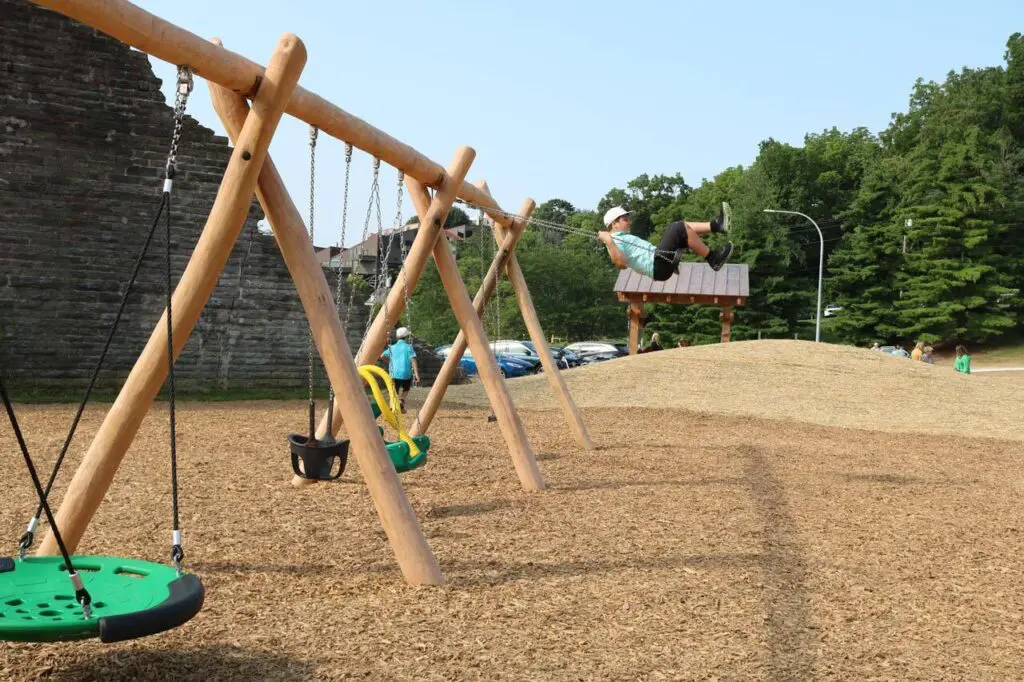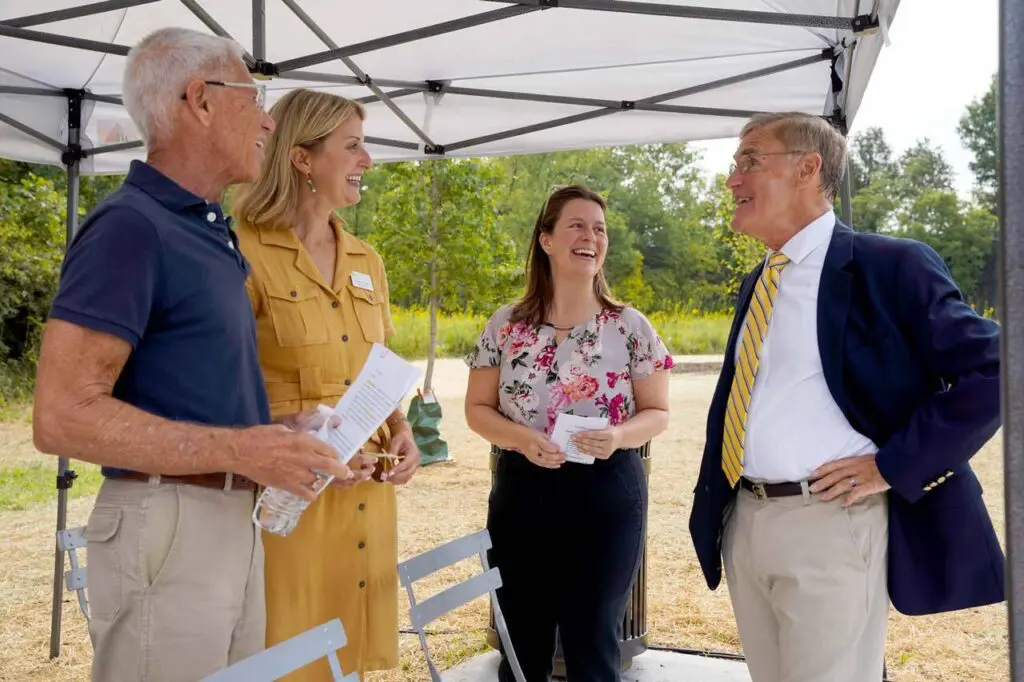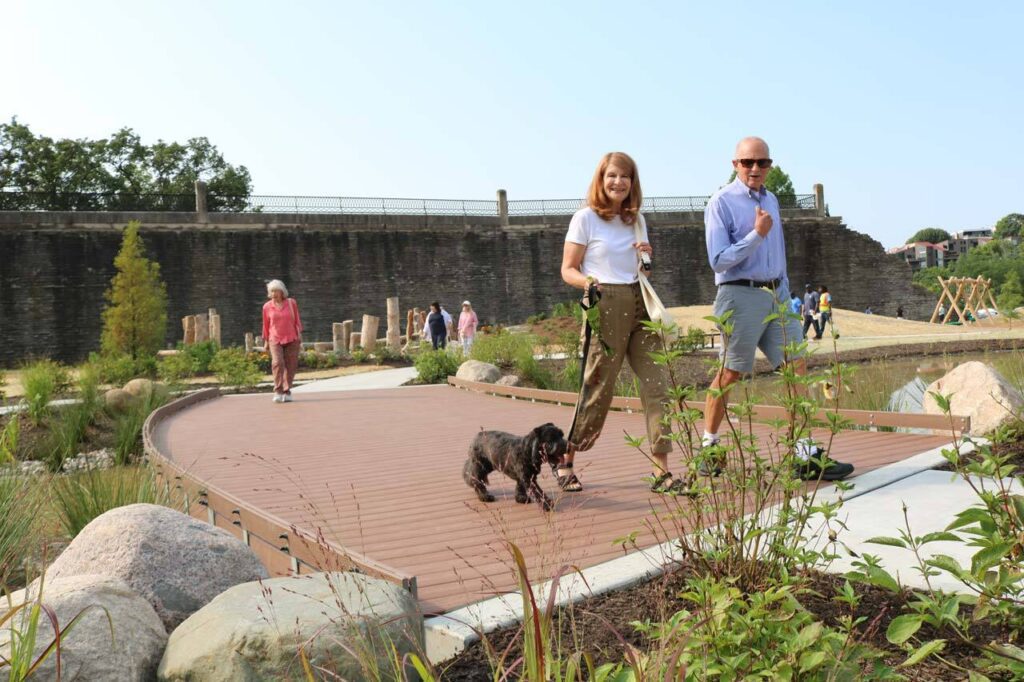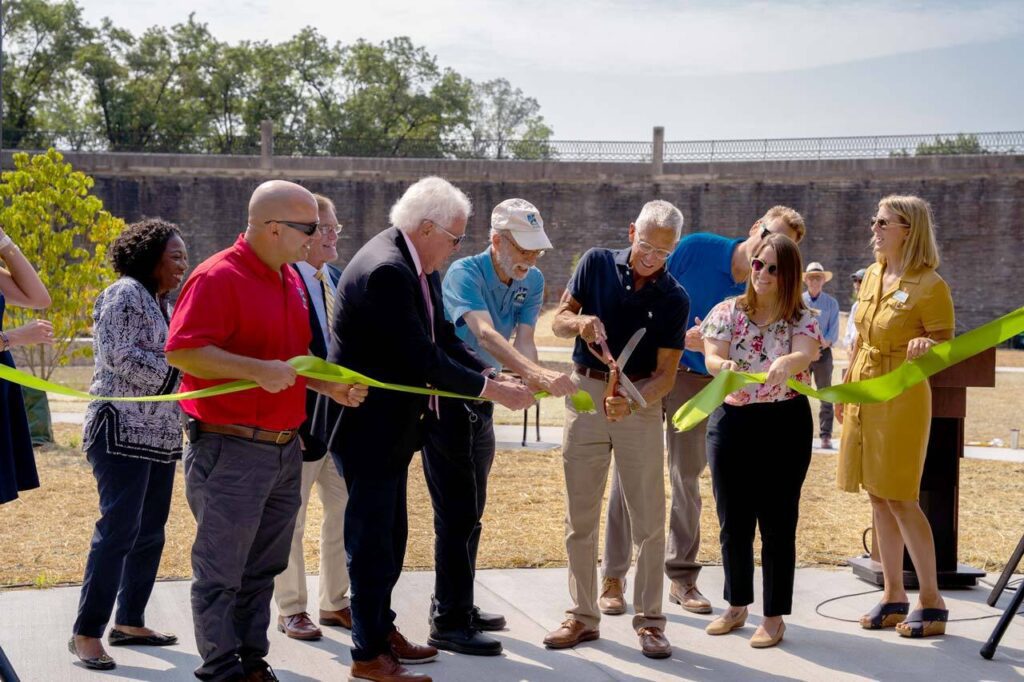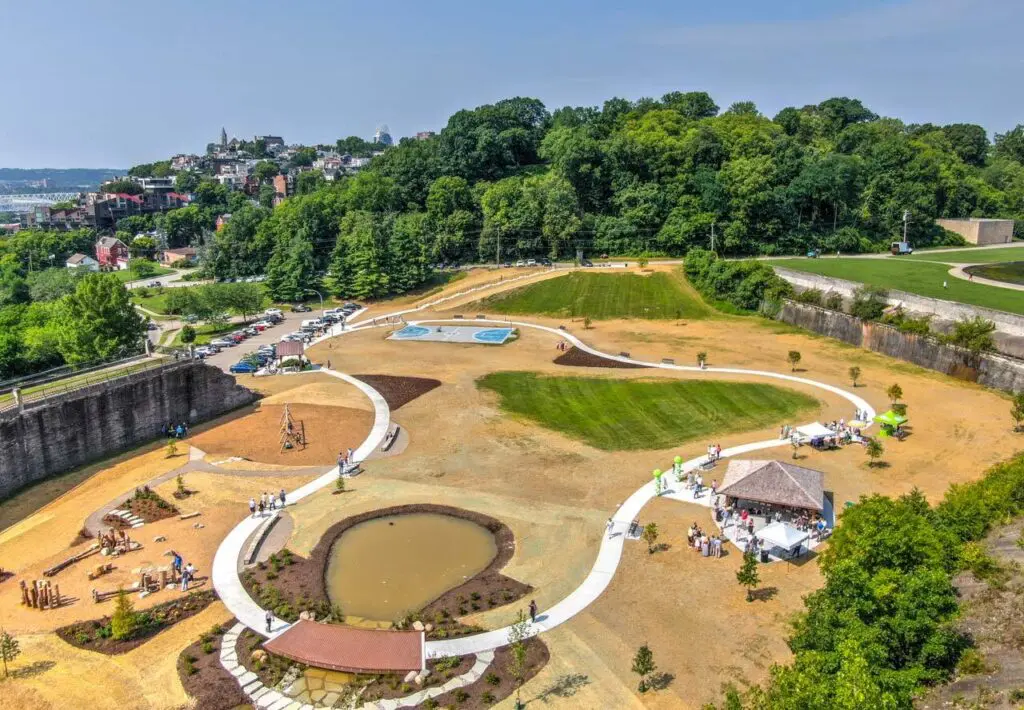Tom Jones Commons
Eden Park is a true urban oasis and is among one of the most visited Cincinnati Parks. People love its diverse features, like Twin Lakes Overlook, Presidential Grove, Krohn Conservatory and Mirror Lake. If you enjoy Eden Park now, we’re excited to share it just got better with its newest attraction. Tom Jones Commons, a 3.5-acre area located south of Mirror Lake and along Martin Drive near the old reservoir, is an important extension of this park because of its many features, like wetlands, new trees, a walking loop, a nature playscape and connectivity to other parts of the park. Our very sincere and special thanks go to the benefactor who made this amazing new space possible, Tom Jones.
How and why did Tom Jones choose this space to leave a legacy and create a place for everyone to enjoy? Well, it’s quite an inspiring story. Tom lived in Mt. Adams for 40 years, and upon retiring from P&G, he began taking morning walks through Eden Park. These daily walks led to friendships with Cincinnati Parks staff including Casey McCann Parks District Crew Leader who would often join Tom, regular encounters with local wildlife, like deer and ducks, and small acts of kindness, such as picking up trash.
Eden Park gave Tom so much, he wanted to return the favor. How could he give back in a meaningful way that would benefit both the park and the community? Tom connected with Steve Schuckman of Cincinnati Parks and Jennifer Spieser of Cincinnati Parks Foundation, and together they created a plan to transform the empty reservoir space below Mirror Lake into a place where community members can gather, recreate, play and explore. Tom described the Commons as “A space coming to life offering something for everyone, a true representation of why I believe in and support parks. Wherever you live, parks make that world a better place for everyone. Be a part of their story. Use and support and caring is your way to say thank you.” We are beyond grateful for his vision and generosity and can’t wait to see the positive impact it has on the park and the community.
“On behalf of our Park Board, staff and especially all of those who use our parks, we offer our gratitude for the generosity and passion of Mr. Tom Jones in the further development of Eden Park at the Tom Jones Commons. We are thrilled to welcome this amazing new feature to our parks system allowing our residents to enjoy this space in new ways for many years to come,” said Kara Kish, Cincinnati Parks Director.
Read more below to learn about the history of Eden Park and the reservoir, and the various features of Tom Jones Commons. We can’t wait to see you out exploring this new part of Eden Park.
History of Eden Park and reservoirs
Cincinnatians of the early nineteenth century generally regarded the area now known as Eden Park as largely useless wasteland. While much of the area lay within the city limits and was not far from the center of town, its rough features and inaccessibility prevented it from being developed.
This changed in 1830 when Nicholas Longworth (1782 – 1863) acquired a great part of this property. During the 1830s and 1840s, he established several vineyards around Cincinnati. This vineyard, which he called the ‘Garden of Eden’, produced excellent Catawba grapes. From these, his wineries made a sparkling wine known as Golden Wedding Champagne.
In 1842 Longworth offered to sell the vineyard to the city for use as parkland. City officials felt the acreage was not worth the price and rejected the proposition.
Disease destroyed southwestern Ohio’s wine industry in the late 1850s ending the Garden of Eden’s use as a vineyard. In the mid-1860s, several years after Longworth’s death, city officials, motivated by concerns about public health, negotiated with Longworth’s son, Joseph (1813 – 1883), to purchase the Garden of Eden. The Board of Health advised more parks were needed to provide city residents with a place to relax in the fresh air. Further, an 1866 Water Works Department report argued a large, new reservoir on high ground would soon be needed to provide water to the growing hilltop suburbs and improve the quality of the water supply.
The area north of Mt. Adams was ideal for both purposes and in 1865 – 1866 the city purchased the Longworth property and several adjoining tracts. This land became Eden Park and was officially opened to the public in 1870/1871.
Shortly after the park was opened to the public, facilities were established within Eden Park to supply uncontaminated water to Cincinnatians. This included a double basin, 100-million-gallon capacity reservoir built from 1866 to 1878. The massive limestone wall around the reservoir was 1,252 feet long, over forty-eight feet thick at the base, and eighteen feet wide at the top. The east/lower basin retaining wall consisted of eight elliptical arches, each spanning 55’. The two basins of the reservoir covered 12 acres. Water was pumped directly from the Ohio River into the reservoir and debris settled in the open basins before the “clean” water flowed into the downtown water main. Whenever cleaning of the basins took place, municipal picnics complete with music and dancing were held inside this empty basin.
In the 1960’s the stone retaining wall of the lower/eastern basin was largely removed and the basin was filled in for ball fields. The upper/western basin was made deeper to increase its capacity to 80,000,000 gallons. In 1965 the reservoir was covered with a shallow reflecting pool named Mirror Lake.
The lower basin remained a largely undeveloped space covered in grass, until Tom Jones generously stepped forward to help transform these 5 acres into a beautiful new park amenity certain to attract and be used by people of all ages and walks of life. Thanks to this project, several signs detailing this historical information, and much more, is presented in a kiosk for park patrons to read and enjoy as part of their visit.
Tom Jones Commons Features
The Missing Piece
Tom Jones Commons truly represents the “missing piece” by, for the first time, connecting Walnut Hills and Mt. Adam neighborhoods, and the amazing institutions in Eden Park, so the entire area can be explored by foot. Now a connection exists between the iconic Krohn Conservatory, the Art Museum, Playhouse in the Park and Cincinnati Ballet. There is also a connection between Tom Jones Commons and Mirror Lake. This continues to advance Cincinnati Parks’ goal of becoming more pedestrian friendly. The welcome kiosk will include information about the links to the community organizations in the vicinity.
Wetlands
Wetlands are areas where standing water covers the soil or an area where the ground is very wet. They can be found along the boundaries of streams, lakes, ponds or even in large shallow depressions that seasonally fill with rainwater. They support all kinds of amphibians, insects, and birds. They also provide flood protection during storms.
The wetland at Tom Jones Commons will support the native wildlife within Eden Park, such as ducks, geese, birds and insects. The wetland plants include, but are not limited to, swamp milkweed, marsh marigold, butterfly weed, June grass, prairie dropseed, Virginia wild rye and soft rush.
Trees
Eden Park is also home to a great diversity of tree species, which have been here for hundreds of years. The original forests were filled with oaks, maples, beech, hickories and walnuts – thus leading to the name of one of the earliest residences in this area, Walnut Hills. In an urban environment, trees reduce air and noise pollution, improve soil quality, prevent erosion and provide shade. Newly planted trees and shrubs found in Tom Jones Commons include sugar maple, black gum, bur oak, redbud and flowering dogwoods. These were carefully selected because they will support local wildlife, such as squirrels, chipmunks, rabbits, groundhogs, raccoons and opossums.
Nature Playscape
Cincinnati Parks staff Kevin Temple, District Crew Leader, and Zach Lawson, Horticulturist, designed and built this exciting new nature playscape to engage and delight children from 4-12 years old, helping connect them with the natural world.
This playscape is built from all natural materials and contains no hardware. All of the logs used in the playscape are from decay resistant species, like Osage orange and black locust, which ensures this is a safe play space for many years. All species used in the design are native, which will make replacement logs easier to come by. We can’t wait to see children putting this nature playscape to good use.
Cincinnati is fortunate to be ranked as a top 10 park system, however as this project represents, no one is resting on their laurels. The Cincinnati Park Board, staff and key partners, such as the Cincinnati Parks Foundation, volunteers, and the sincere generosity of individuals such as Tom Jones, are working to seize every opportunity to improve our parks, amenities and programs for the enjoyment of everyone.

